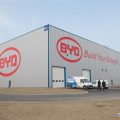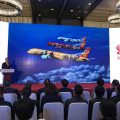
Global player has deep insights into optoelectronics and the world of optics
Michael Kaschke has a relentless focus, vision and passion for his company. Which is understandable, given that he is president and CEO of Carl Zeiss AG, one of world’s biggest optical and optoelectronic solutions suppliers.
Optoelectronics is the study and application of electronic devices and systems that source, detect and control light, a study which is usually considered a sub-field of photonics.
Kaschke said he believes Zeiss is bringing in the right products and solutions at the right time-fitting in with the general trend as Chinese industries and consumers move up the value chain.
Working with Zeiss for more than 25 years, including 17 years on the executive board, Kaschke said the scope of the company’s business-how it helps empower businesses and individuals-is something he finds fascinating.
A physicist with two doctoral degrees, Kaschke said he is a true believer in openness, the values of quality, and in precision.
In China’s context, that is how Zeiss can meet new demand from the market-where new technologies, new materials and new surfaces emerge. These, he said, require close investigations and studies into industries, and into people’s surging demand.
“We have all these tools, all these solutions that help us focus on Chinese industry and customers-with new materials and better use of resources-can do a better job,” he said.
Recently, he spoke with China Daily about the company’s strategy, business opportunities and prospects. The following are edited excerpts from the interview:
How is your company’s performance in the China market and the Asian market in general?
China is becoming more important-more and more-for the global business of Zeiss. Right now our China revenue is the third biggest for the entire Zeiss group and it will soon be the second biggest. But what is also important is that we’ve seen very, very good growth over the years. Today more than 25 percent of our total business comes from the Asia-Pacific region, while 10 years ago it was 11 percent. Of this, China really has the lion’s share. In the Asia-Pacific region, our revenue more than doubled, and in China more than tripled in the period.
How do you assess market growth in China in terms of the optical and optoelectronics sector?
It is a growing market. But in a growing market, you also have to have the right product. For example, take our measuring machines, our quality enhancing machines for the automotive industry.
Also we have the right products and solutions for the machine tool industry, for generally any manufacturing industry. Our products are in a number of industries-from automotive to aerospace-and they enhance the quality and efficiency of Chinese manufacturing. They also play a key role in the healthcare industry, so not surprisingly we are No 1 in ophthalmology and eye care in China.
How does Zeiss differentiate itself from other market players?
First, I will say this: we are here in China for the long run; we are not just trying to make a quick return on our money, so we have a long-term strategy.
Second, from the very beginning, we said we wouldn’t go to China with second-class products. If we produce our products here ourselves or if we bring products to China, they have to be top quality.
And third, we follow a holistic approach. We have research and development here, product management here, pre-fabrication here, systems integration here and applications support here.
What are the major drivers of business growth for Zeiss in China?
With economic development and more affluence in China, people want to take better care of their health. Health becomes very important. Also because of the one-child policy, for a long time parents paid a lot of attention to the health of their only child. Put together there’s been an enormous demand for healthcare technology-good reliable healthcare technology.
The second business which has grown the fastest in the last 10 years has been our industrial metrology business, dealing with the application of measurement science to manufacturing and other processes.
This has taken off, with factories being built here in the automotive and other industries.
What role does Zeiss play in the emerging augmented reality sector?
Augmented reality, we believe, has strong potential, and we even differentiate between full augmentation and so-called data augmentation, where we basically just put data and information in front of the eye. Full augmentation would be overlaying some virtual reality onto reality.
For example, when you navigate through streets, you might want some directional information overlaid onto your lens. Or, when I am in China, I would like to get a translation from Chinese into English or German. This is what we called data overlay. In these two areas we are very active.
What experience can Zeiss share in terms of smart manufacturing?
An important element to smart manufacturing is training and educating people. In China we have non-product-related training, general training, then product or skills-related training.
We’ve paid a lot of attention to and put a lot of emphasis on training and qualifying people. We have specialty technology and quality enhancing technology, but we also have a very big focus on training. So that’s what I think other companies can learn from us-it’s the combination of technology and good people, well-skilled and trained people.
How does Zeiss cooperate with local partners?
When we started manufacturing, parts sourced locally in China were below 20 percent. Now we are at 90 percent and sometimes even 100 percent. It is a learning process to find which partners can meet our quality requirements. You have to learn together. It’s not something you can expect to happen overnight.
We work very closely with customers in developing new applications. We cooperate with research institutions on the development of new technologies, or in sharing new technologies. It’s really a two-way exchange. I really believe that if we meet again in five years I would be able to tell you that China has become one of the four or five global centers of the Zeiss network of companies.
What is your view on the Belt and Road Initiative and the trend of Chinese enterprises going global?
I am a true believer in free trade. I think this initiative is going in the right direction. One still has to see how they work it out in detail. Let’s bring people together. Let’s allow free trade and free movement of goods and ideas. I think there are still improvements which can be made in China, but this is a good initiative.
I also say, for me it’s not a concern when Chinese come to Germany to invest in or buy companies, as long as it goes both ways.
How would you describe your own leadership style in the Zeiss group?
My background is a scientist. So I think I still take to a very large extent a very analytical approach, which is generally true for the company. I spend a lot of time on the road talking to many people-to customers and people working in the medical industry. I also teach at universities, so I try to stay in touch with research and students.
I am a big believer in diversity. We should become a global company with strong German roots-I don’t want to give up the roots. Every tree has roots. But it grows. I push considerably for internationalization, for globalization.
How do you balance life and work?
Sports helps. This morning I ran around Century Park. So if I have an hour or so, I like to spend it outdoors. I do a lot of outdoor hiking, mountaineering, climbing-climbing most of the high peaks in Germany and Austria.
I really like the outdoors as well as music-I enjoy going to the opera. I like stargazing, so I have a telescope, to look at stars and galaxies. I have a decent, semi-professional telescope at work. I try to observe solar eclipses.
CV
Age: 59
Nationality: German
Career:
2011 onwards: President and Chief Executive Officer of Zeiss Group
2008-10: President and CEO of Carl Zeiss Meditec AG
2000: Board of Management of Carl Zeiss AG
1999: Executive vice-president& general manager, Medical Technology business group and Member of the Executive Management Committee
1998: Vice-president & general manager, surgical products division
1995: Vice-president& general manager, surveying instruments division
1992: Joined Zeiss as a research scientist, subsequently R&D director, surgical microscopes
Education:
1988: PhD, Dr. sc. nat
1986: PhD, Dr. rer. nat
1983: Degree in Physics, Friedrich Schiller University, Jena, Germany
Hobbies: Sport, music and astronomy


